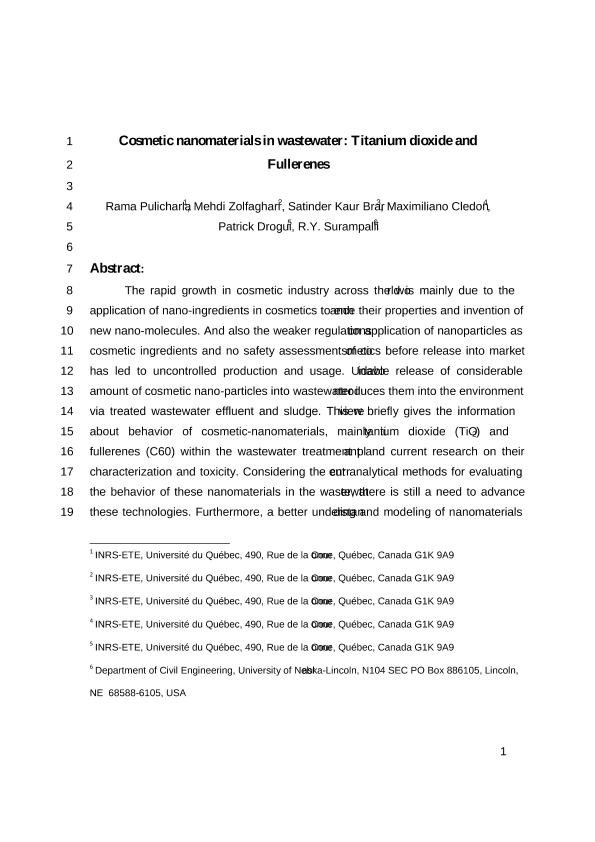Mostrar el registro sencillo del ítem
dc.contributor.author
Pulicharla, Rama

dc.contributor.author
Zolfaghari, Mehdi

dc.contributor.author
Brar, Satinder Kaur

dc.contributor.author
Cledón, Maximiliano

dc.contributor.author
Drogui, Patrick

dc.contributor.author
Surampalli, R. Y.
dc.date.available
2018-02-02T19:56:29Z
dc.date.issued
2016-01
dc.identifier.citation
Pulicharla, Rama; Zolfaghari, Mehdi; Brar, Satinder Kaur; Cledón, Maximiliano; Drogui, Patrick; et al.; Cosmetic Nanomaterials in Wastewater: Titanium Dioxide and Fullerenes; American Society of Civil Engineers; Journal of Hazardous, Toxic, and Radioactive Waste; 20; 1; 1-2016; 1-44
dc.identifier.issn
2153-5493
dc.identifier.uri
http://hdl.handle.net/11336/35552
dc.description.abstract
The rapid growth in the cosmetic industry across the world is mainly due to the application of nanoingredients in cosmetics to enhance their properties and invention of new nanomolecules. Also, the weaker regulations on the application of nanoparticles as cosmetic ingredients and no safety assessment of cosmetics before release into the market has led to uncontrolled production and usage. Unavoidable release of a considerable amount of cosmetic nanoparticles into wastewater introduces them into the environment via treated wastewater effluent and sludge. This paper briefly gives the information about behavior of cosmetic nanomaterials, mainly titanium dioxide (TiO2TiO2) and fullerenes (C60), within the wastewater-treatment plant and current research on their characterization and toxicity. Considering the current analytical methods for evaluating the behavior of these nanomaterials in the wastewater, there is still a need to advance these technologies. Furthermore, a better understanding and modeling of nanomaterials’ fate in wastewater-treatment plants is essential for effectively predicting their impacts on the receiving environment.
dc.format
application/pdf
dc.language.iso
eng
dc.publisher
American Society of Civil Engineers

dc.rights
info:eu-repo/semantics/openAccess
dc.rights.uri
https://creativecommons.org/licenses/by-nc-sa/2.5/ar/
dc.subject
Cosmetic Nanomaterials
dc.subject
Titanium Dioxide
dc.subject
Fullerenes
dc.subject
Fate in Wastewater
dc.subject
Toxicity
dc.subject
Characterization
dc.subject.classification
Nano-materiales

dc.subject.classification
Nanotecnología

dc.subject.classification
INGENIERÍAS Y TECNOLOGÍAS

dc.subject.classification
Otras Ciencias Biológicas

dc.subject.classification
Ciencias Biológicas

dc.subject.classification
CIENCIAS NATURALES Y EXACTAS

dc.title
Cosmetic Nanomaterials in Wastewater: Titanium Dioxide and Fullerenes
dc.type
info:eu-repo/semantics/article
dc.type
info:ar-repo/semantics/artículo
dc.type
info:eu-repo/semantics/publishedVersion
dc.date.updated
2018-01-30T19:03:23Z
dc.journal.volume
20
dc.journal.number
1
dc.journal.pagination
1-44
dc.journal.pais
Estados Unidos

dc.description.fil
Fil: Pulicharla, Rama. Université du Québec; Canadá
dc.description.fil
Fil: Zolfaghari, Mehdi. Université du Québec; Canadá
dc.description.fil
Fil: Brar, Satinder Kaur. Université du Québec; Canadá
dc.description.fil
Fil: Cledón, Maximiliano. Université du Québec; Canadá. Consejo Nacional de Investigaciones Científicas y Técnicas. Centro Científico Tecnológico Conicet - Mar del Plata. Instituto de Investigaciones Marinas y Costeras. Universidad Nacional de Mar del Plata. Facultad de Ciencia Exactas y Naturales. Instituto de Investigaciones Marinas y Costeras; Argentina
dc.description.fil
Fil: Drogui, Patrick. Université du Québec; Canadá
dc.description.fil
Fil: Surampalli, R. Y.. Universidad de Nebraska - Lincoln; Estados Unidos
dc.journal.title
Journal of Hazardous, Toxic, and Radioactive Waste
dc.relation.alternativeid
info:eu-repo/semantics/altIdentifier/doi/http://dx.doi.org/10.1061/(ASCE)HZ.2153-5515.0000261
dc.relation.alternativeid
info:eu-repo/semantics/altIdentifier/url/https://ascelibrary.org/doi/abs/10.1061/(ASCE)HZ.2153-5515.0000261
Archivos asociados
